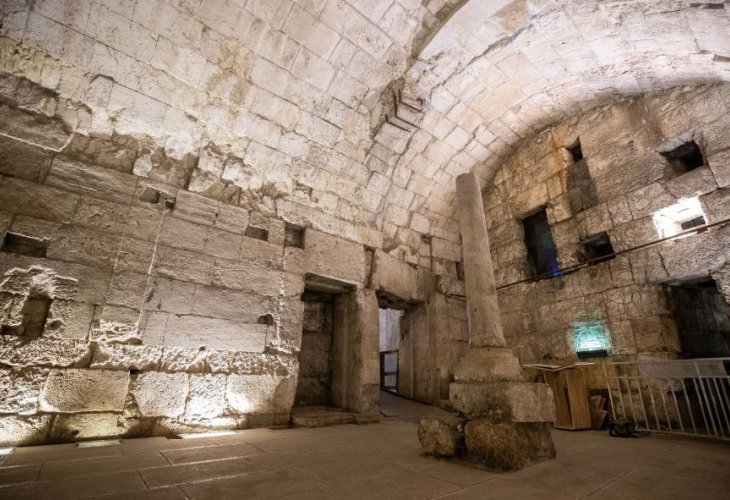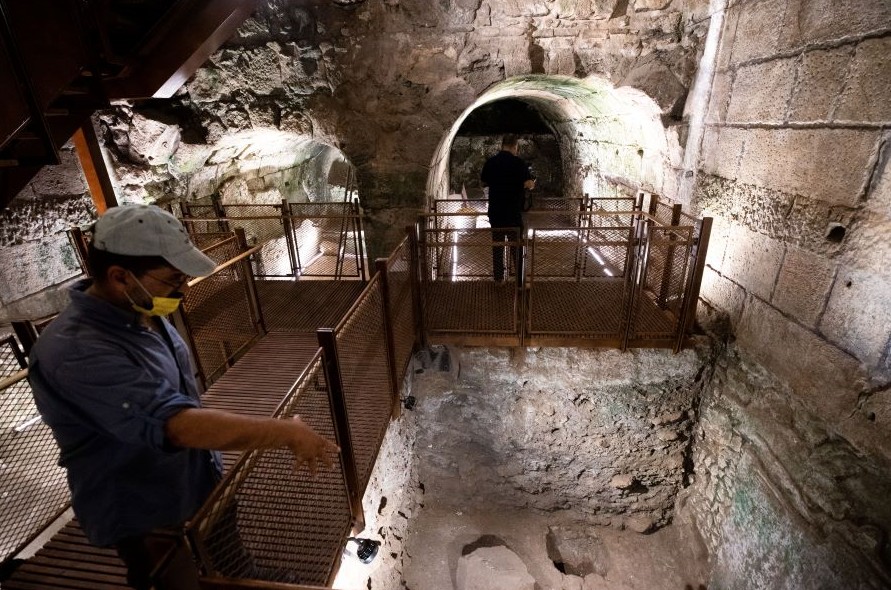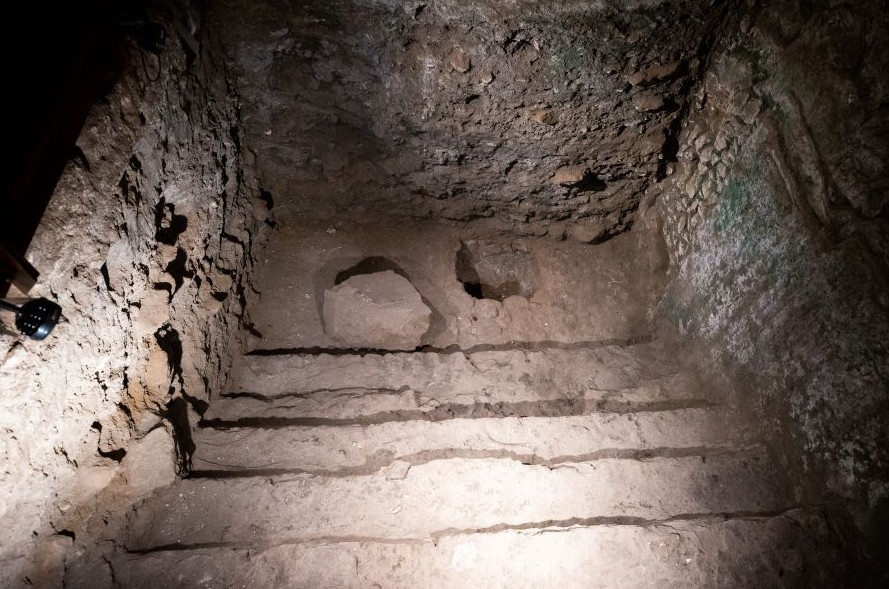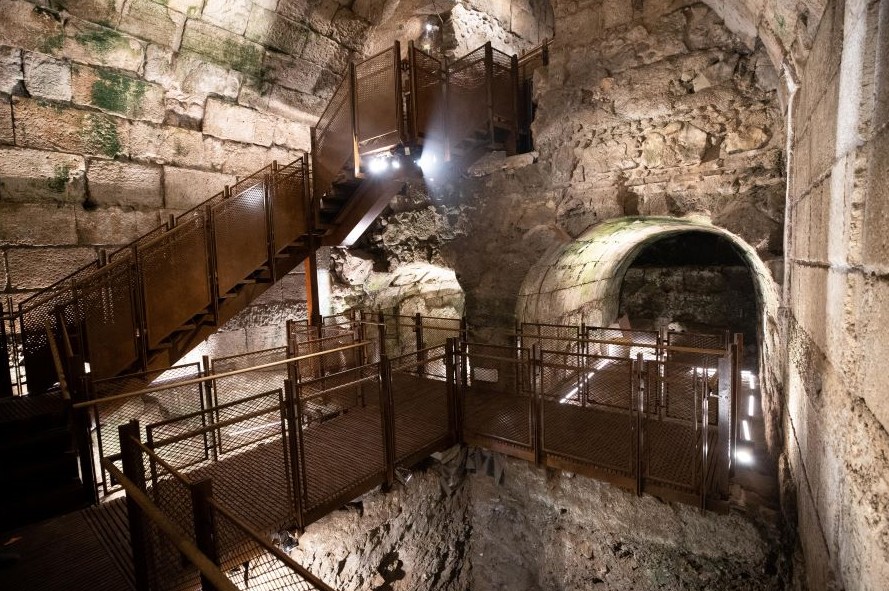Discovering History: A Glimpse into Jerusalem's Second Temple Era
The Western Wall Heritage Foundation and the Israeli Antiquities Authority unveil a magnificent 2,000-year-old public building.
 Remains of the grand structure from 2,000 years ago (Photo: Yonatan Sindel, Flash 90)
Remains of the grand structure from 2,000 years ago (Photo: Yonatan Sindel, Flash 90)The Western Wall Heritage Foundation and the Israeli Antiquities Authority today (Thursday) revealed remarkable new parts of one of Jerusalem's most magnificent public buildings from the Second Temple period. This discovery, the result of an archaeological excavation conducted over recent years in the Western Wall Tunnels, will be available to visitors as part of a new tour route opening ahead of Rosh Chodesh Elul and the Selichot period.
Part of the building, uncovered west of Wilson's Arch and the Temple Mount, was initially documented by Charles Warren in the 19th century and by various archaeologists throughout the 20th century. The current excavation has completed its unveiling, now known to include two identical grand halls with an advanced fountain between them. The halls' walls and the fountain wall are decorated with ornate cornice featuring pilasters—flat, recessed columns—topped with Corinthian capitals. These decorations are typical of the luxurious construction style of the Second Temple period.
 (Photo: Yonatan Sindel, Flash 90)
(Photo: Yonatan Sindel, Flash 90)"This is undoubtedly the most luxurious public building from the Second Temple period uncovered thus far in Jerusalem outside the Temple Mount," said Dr. Shlomit Weksler-Bdolah, excavation director on behalf of the Israeli Antiquities Authority. "It was constructed between 20-30 CE. The building, likely situated along the route ascending to the Temple Mount, was used for public purposes—possibly even hosting the city council or dignitaries prior to entering the Temple and Temple Mount complex."
According to Dr. Weksler-Bdolah, "Visitors can imagine the magnificence of the place: Two side halls served as elegant lounges with a grand fountain between them—where water flowed through lead pipes embedded in the center of Corinthian-style capitals protruding from the wall. Original, large, and impressive paving stones were also uncovered during the excavation, which paved the ancient building. Archaeologists believe that the banquet halls, which also served for meals, were furnished with wooden reclining sofas, none of which have survived."
The Israeli Antiquities Authority noted that dining rooms with reclining arrangements were common in the Greek, Hellenistic, and Roman worlds from the 5th century BCE to the 3rd-4th centuries CE. Archaeological findings show these rooms in private homes, palaces, temples, synagogue complexes, and civil sites.
 The stepped pool used as a purification mikveh (Photo: Yonatan Sindel, Flash 90)
The stepped pool used as a purification mikveh (Photo: Yonatan Sindel, Flash 90)In the waning years of the Second Temple, before the Temple's destruction, this building underwent transformation amid broader regional changes. It was divided into three separate halls, one of which housed a stepped pool used as a mikveh for purification.
Shachar Puni, an architect with the Israeli Antiquities Authority's Conservation Department, added: "The new route provides a better understanding of the complex and significant site known as the Western Wall Tunnels, emphasizing the opulent structure uncovered. This creates a new visitor trail that passes through the building and continues to the expansive complex beneath Wilson's Arch (one of the bridges leading to the Temple Mount), recently exposed in excavations by the Western Wall Heritage Foundation and the Israeli Antiquities Authority. By setting up and opening this path to visitors, they can explore one of Jerusalem's most fascinating and impressive sites."
 The new route in the Western Wall Tunnels (Photo: Yonatan Sindel, Flash 90)
The new route in the Western Wall Tunnels (Photo: Yonatan Sindel, Flash 90)Mordechai "Soli" Eliav, Director General of the Western Wall Heritage Foundation, expressed: "It's exciting to uncover such a magnificent building from the Second Temple days during a time when we mourn the destruction of Jerusalem and pray for its rebuilding. These rooms are part of a new route in the Western Wall Tunnels, where visitors will witness fascinating artifacts and walk the path of Second Temple history for the first time, gaining insights into the complex lives of Jews in Jerusalem between the Hasmonean and Roman periods and their significance up to the present day."

